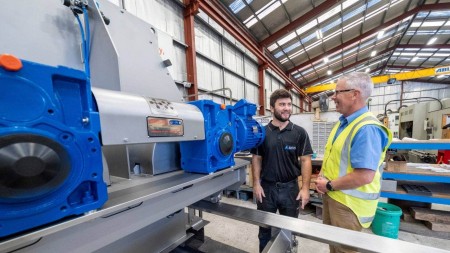e ngineering
a brighter future
NEWS

17 January 2021
After New Zealand closed its borders due to the Covid-19 pandemic, employers in some industries which relied on migrant labour have struggled to find skilled workers to fill the gaps.
The Government’s ‘Reform of Vocational Education’ aimed to plug that gap, and unions wanted companies to take up the challenge and increase their own focus on upskilling.
Stafford Engineering – which supplies key components for Fisher & Paykel Healthcare, and manufactures food processing and packaging equipment – had 10 people learning on the job among its staff of 65.
“I’d like to see more employers playing their part,” said managing director Kaleb James, who started his career in the early 1990s as an apprentice.
Of Stafford’s two latest apprentices, automotive technician Adam Wood decided to retrain as a fabrication engineer, and Matthew Blackie was made redundant by another company where he was an apprentice.
Companies that took on apprentices were in the minority in his industry, he said.
There’s quite a few small businesses around with only a couple of guys in the shop, and it’s very hard to take on an apprentice.
“I think it’s fairly obvious that as a country if industry training is something we really need to be doing, then a lot of places are missing the mark, and not doing enough, and wondering why they can’t get good, skilled staff.”
The advantage was being able to train people to meet the standards and needs of the business. In fact, James preferred to train someone who had not already studied elsewhere.
“We’ve seen more success taking people directly from school. It’s probably that they’re a bit greener and a bit fresher, so they’re a little bit more malleable really.
“For a lot of them it’s generally their first job, other than a part-time job, so it can be quite a daunting task to come into a workshop full of blokes who know what they’re doing and be the guy who’s standing around wondering what to do next.”
One of the 10 current trainees was a woman, one of several female apprentices the company had taken on.
The company had a high retention rate, and found the best staff were those it had invested in over the years.
James was concerned that some of the Government’s current vocational education reform was going to reverse the progress in improving skills.
“Some of what they’re doing is right, but the last time there was a government reform around trade training which was in the late 90s, they created a 10-year skills gap which we’re only just recovering from now.”
However, James said the Government’s incentives to businesses to take on apprentices were welcome.
The Government’s $1.6 billion trades and apprenticeships training package in last year’s Budget included fees free programme for trainees, and the apprenticeship boost scheme which provided businesses up to $16,000 for each first and second year apprentice.
“I think it’s long overdue to incentivise training – for us as a business it’s a huge cost but it’s one we’re prepared to take on.”
His attitude towards apprenticeships was partly as a result of his own experience, he said.
“I could have quite easily gone to university and wasted away four years of my life and ended up in a serious amount of debt before I even got started into work. But quite the opposite happened, and engineering has taken me a lot of places, and it’s definitely looked after me.
“So I feel like part of what our business needs to do is also give back.”
General manager of not-for-profit organisation Apprentice Training NZ (ATNZ) Susanne Martin agreed that the number of firms in the engineering industry prepared to take on an apprentice was “far too low”.
However, she said apprenticeships through ATNZ were up about 13 per cent on forecast, in large part because of the government incentives but also because of how well the country had managed the coronavirus pandemic.
“We’ve had less terminations of apprenticeships than we thought may be the case post-Covid, and we’ve had more uptake as well.”
Under the scheme, the host company paid the hourly rate for the apprentice, plus a margin to cover costs such as recruitment and pastoral care visits, to ATNZ. The Government had made up to $19.3 million funding available to such group training schemes until June.
She hoped businesses would not go back to importing labour once the border opened.
“It’s a chicken and egg – if we’ve got more apprentices being trained in how to do it and therefore we’ve got more tradespeople coming out the end, then there’s less need for them to go offshore [for workers[.”
ATNZ had about 350 apprentices on its books placed with host companies, about 30 more than anticipated, and the vast majority of them had done no training before signing up.
“The whole earn-while-you learn concept is actually really attractive to a lot of young people, because they’re not earning megadollars but they’re earning dollars as opposed to university where they’re borrowing money on a student loan that they’re going to take 20 or 30 years to pay back.
“And they’re going to walk out with a qualification – not a degree, but a qualification that will put them in good stead after four years to be able to go out as a tradesperson and earn some fairly substantial coin.”
This story first appeared on stuff.co.nz.
